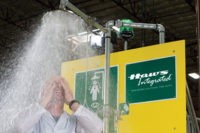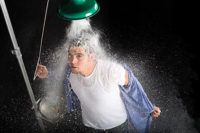Companies cite various reasons for failing to install emergency showers and eyewash stations where needed. This despite the fact there is a standard (ANSI Z358.1) that covers everything companies need to know about emergency showers and eyewashes — such as location, flow rate and water temperature.
|
4 reasons companies give for failing to install emergency showers & Eyewashes
|
| A misunderstanding of provisions of ANSI Z358.1. |
| Mechanically difficult locations. |
| Mistakes made in calculating the water supply/temperature or confusion over the piping. |
| The remote nature of some required shower locations. |
Do you need an emergency shower/eyewash?
If corrosives, strong irritants or other kinds of toxic chemicals (including pesticides) are used in your workplace, the answer is, “yes.” These substances can destroy living tissue, be absorbed through the skin and cause serious long-term health effects.
That’s why it’s important to have emergency showers and eyewash stations close at hand. Flushing away hazardous chemicals and contaminants can help avoid or limit the extent of injuries. (In some circumstances, quick and effective flushing can even save a worker’s eyesight.)
The first ten to 15 seconds after exposure — especially in the case of a corrosive chemical — are critical.1
Chemicals that call for the use of emergency showers and eyewashes include: bleach, formaldehyde, acids, sodium hydroxide, anhydrous ammonia (gas), aqueous ammonia, chlorine gas, industrial cleaning chemicals, boiler chemicals, pesticides and many solvents.
If you’re not sure about the substances present in your workplace, check safety data sheets for chemical properties and eyewash recommendations.
The ten second/50 feet rule
A worker must be able to reach emergency washing facilities in ten seconds or less, traveling no more than 50 feet on a single level that is free of obstructions.
Emergency eyewashes and showers are required where there is the potential for an employee to come into contact with the substances mentioned above. Both must deliver tepid (60-100˚F) water for at least 15 minutes.
If the water is too hot or too cold, the worker’s instinct may be to keep the clothing on as a protective barrier. That, unfortunately, will increase his exposure to the hazardous materials which have been absorbed into the clothing. The proper water temperature can also help to prevent burns and hypothermia.
The eyewash must allow the user to hold the eyes open with both hands while irrigating and flushing both eyes simultaneously. Its on-off valve must be activated in one second and remain open. It must deliver at least 0.4 gallons per minute or 3 gallons per minute for an eye/face wash.
Emergency showers must provide 20 gallons of water per minute.
Four challenges
Here are reasons companies give for failing to install the equipment, or to install it where it is needed:
1) A misunderstanding of provisions of ANSI Z358.1. For example, a shower that’s installed within 10 seconds’ walking distance but down a short flight of stairs is still not correctly sited.
2) Mechanically difficult locations. A shower may need to be installed inside a burm (a walled containment area) but the company owner does not want the shower water to flood the inside of the area, so they install it outside the area.
3) Mistakes made in calculating the water supply/temperature or confusion over the piping. For example, “I have lots of interior piping so I do not need to supply warm water.”
4) The remote nature of some required shower locations. Some company owners may feel that it’s too expensive to install a shower hundreds of feet from their facility. They think: Maybe we don’t need a shower there at all. We’ll just use a small, portable eyewash.
Resolving these challenges might require you to call on a safety shower and eyewash specialist.
It’s important to remember that the equipment must not be blocked in any way. An employee who’s had a toxic chemical splashed in his eyes and is stumbling toward relief will lose precious time if he has to navigate around any obstacles or down stairs.
Facilities in places like Houston, Phoenix and Southern California are likely to have outdoor plumbing that becomes too hot and sends scalding water to the shower. Temperature can also be an issue in indoor steel production or smelting plants, where the indoor temperature normally exceeds 100˚F. Showers may need to be located high up on mezzanines or on top of tanks. Showers in battery charging rooms may need a sump pump or other water control system.
A little known fact about the ANSI standard is that it requires a minimum of 30 psi water supply pressure to reach the inlet of the drench equipment – regardless of the equipment. A plumbed eyewash and a combination shower-eye/face wash both have this requirement. Flow controls in the equipment can handle the flow difference.
References
1. Presentation by Wash. state Div. of Occupational Safety and Health – 11/09 wisha-training.lni.wa.gov/training/presentations/emergwash.ppt




